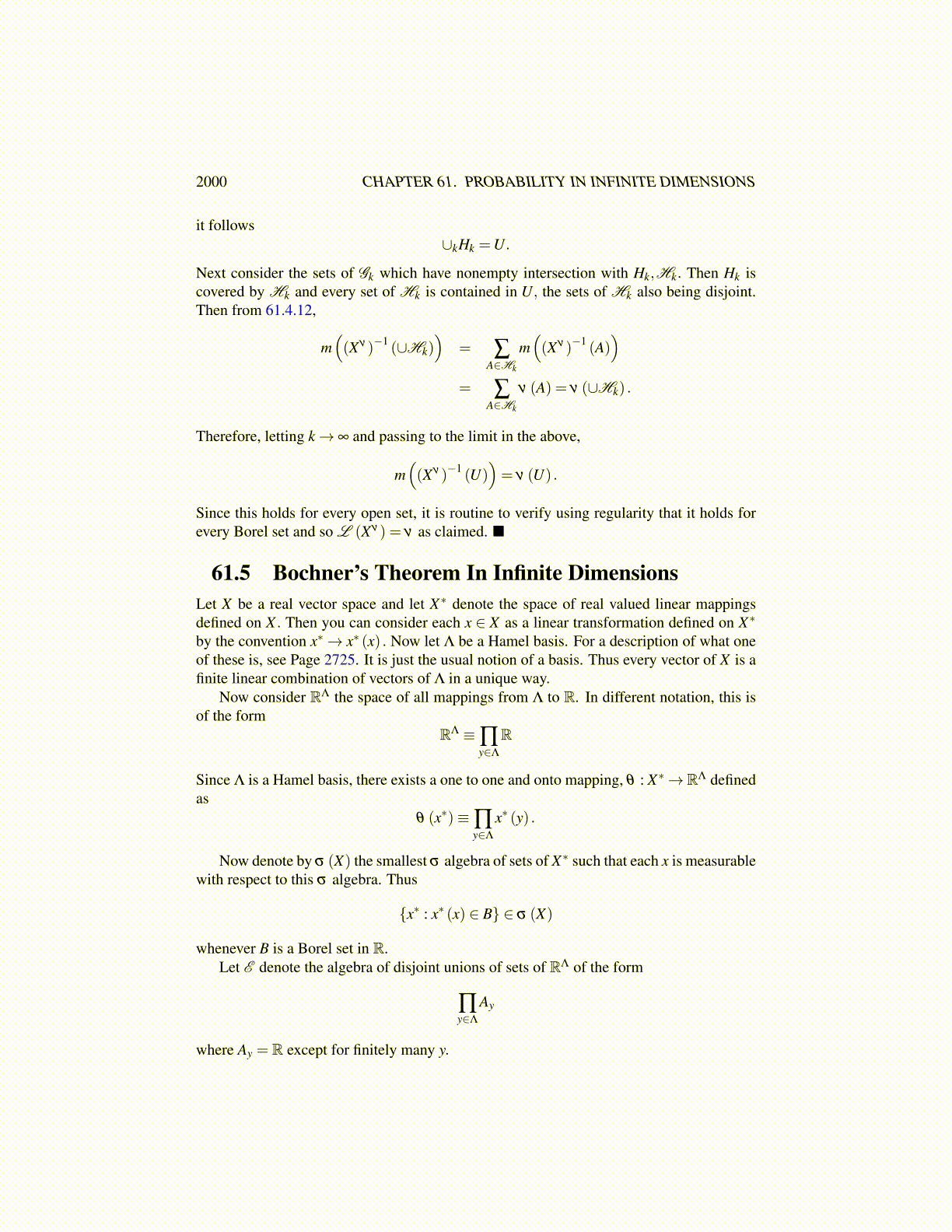
2000 CHAPTER 61. PROBABILITY IN INFINITE DIMENSIONS
Proof of the claim: From Claim 3 and letting ε > 0 be given, there exists m largeenough that for all n,
supω
d(Zµn
m (ω) ,X µn (ω))< ε/3, sup
ω
d (Zµm (ω) ,X µ (ω))< ε/3.
for ω off a set of measure zero. Now pick ω ∈ [0,1) such that ω is not equal to anyof the end points of any of the intervals,
{Iνi1,··· ,im
}, this countable set of endpoints, a
set of Lebesgue measure zero. Then by Claim 2, there exists N such that if n ≥ N, thend(Zµn
m (ω) ,Zµm (ω)
)< ε/3. Therefore, for such n and this ω,
d (X µn (ω) ,X µ (ω)) ≤ d(X µn (ω) ,Zµn
m (ω))+d(Zµn
m (ω) ,Zµm (ω)
)+d (Zµ
m (ω) ,X µ (ω))
< ε/3+ ε/3+ ε/3 = ε.
This proves the claim.
Showing L (Xν) = ν .
This has mostly proved the theorem except for the claim that L (Xν) = ν for ν =
µn and µ. To do this, I will first show m((Xν)−1 (∂Ai1,··· ,im)
)= 0. By the construction,
ν (∂Ai1,··· ,im) = 0. Let ε > 0 be given and let δ > 0 be small enough that
Hδ ≡ {x ∈ E : dist(x,∂Ai1,··· ,im)≤ δ}
is a set of measure less than ε/2. Denote by Gk the sets of the form Ai1,··· ,ik where(i1, · · · , ik) ∈ Nk. Recall also that corresponding to Ai1,··· ,ik is an interval, Iν
i1,··· ,ik havinglength equal to ν
(Ai1,··· ,ik
). Denote by Bk those sets of Gk which have nonempty inter-
section with Hδ and let the corresponding intervals be denoted by I νk . If ω /∈ ∪I ν
k , thenfrom the construction, Zν
p (ω) is at a distance of at least δ from ∂Ai1,··· ,im for all p≥ k. (IfZν
k (ω) were in some set of Bk, this would require ω to be in the corresponding Iνk and it is
assumed this does not happen. Then for any p > k,Zνp (ω) cannot be in any set of Gp which
intersects Hδ either. If it did, you would need to have ω /∈ ∪I νp but all of these intervals
are inside the intervals I νk .) Passing to the limit as p→ ∞, it follows Xν (ω) /∈ ∂Ai1,··· ,im .
Therefore,(Xν)
−1(∂Ai1,··· ,im)⊆ ∪I ν
k
Recall that Ai1,··· ,ik ⊆ B(aik ,rk
)and the rk→ 0. Therefore, if k is large enough,
ν (∪Bk)< ε
because ∪Bk approximates Hδ closely (In fact, ∩∞k=1 (∪Bk) = Hδ .). Therefore,
m((Xν)
−1(∂Ai1,··· ,im)
)≤ m(∪I ν
k )
= ∑Iνi1 ,··· ,ik
∈I νk
m(Iνi1,··· ,ik
)= ∑
Ai1 ,··· ,ik∈Bk
ν(Ai1,··· ,ik
)= ν (∪Bk)< ε.